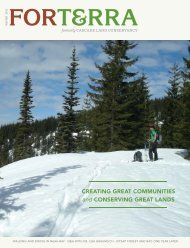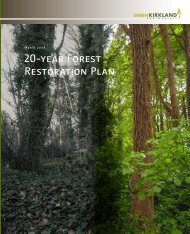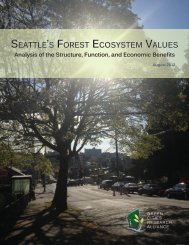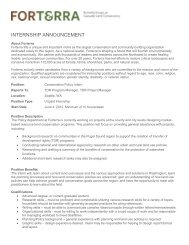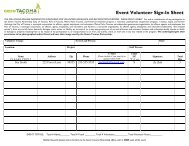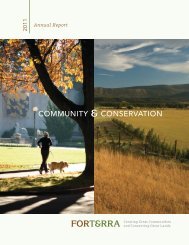Download the new Green Cities Research Alliance Accomplishment ...
Download the new Green Cities Research Alliance Accomplishment ...
Download the new Green Cities Research Alliance Accomplishment ...
- No tags were found...
You also want an ePaper? Increase the reach of your titles
YUMPU automatically turns print PDFs into web optimized ePapers that Google loves.
GREENCITIESRESEARCHALLIANCEThe <strong>Green</strong> <strong>Cities</strong> <strong>Research</strong> <strong>Alliance</strong> (GCRA) was initiated by<strong>the</strong> USDA Forest Service, Pacific Northwest <strong>Research</strong> Stationin 2009 to build a program of social and biophysical researchsciences on urban ecosystems in <strong>the</strong> Puget Sound region.Through an integrated social-ecological research program,GCRA meets <strong>the</strong> practical needs and concerns of organizationsand agencies that links to investigations in o<strong>the</strong>r U.S.urban areas.GCRA pairs scientists with practitioners and local decisionmakers to co-design and implement research and programmingefforts that provide relevant and practical information.Major collaborators include <strong>the</strong> University of Washington, KingCounty, and Forterra.Initial funding for this work was provided in part by <strong>the</strong>American Recovery and Reinvestment Act (ARRA).In accordance with Federal law and U.S. Departmentof Agriculture (USDA) policy, this institution is prohibitedfrom discriminating on <strong>the</strong> basis of race, color, national origin,sex (in education and training programs and activities),age, disability, or retaliation.For more information, visit:www.fs.fed.us/pnw/research/gcra/Or contact lead scientists:Dale Blahna, PhD - dblahna@fs.fed.usUSDA Forest Service, Pacific Northwest <strong>Research</strong> StationKathleen Wolf, PhD - kwolf@uw.eduUniversity of Washington, College of <strong>the</strong> Environment
Recent Science and Management ResultsPresented below are <strong>the</strong> research programs and initial results that have been <strong>the</strong> central work of <strong>the</strong> <strong>Green</strong> <strong>Cities</strong> <strong>Research</strong><strong>Alliance</strong> over <strong>the</strong> past three years. A wide range of scientific and science delivery products have been derived from primarydata collection, and many of <strong>the</strong> products directly translate science to policy or management needs. <strong>Research</strong> was conductedin <strong>the</strong> Pacific Northwest, in and around Seattle and o<strong>the</strong>r urban centers. An initial list of publications and presentations basedon this work is provided at <strong>the</strong> end of this report.Stewardship EngagementAssessment of Volunteer Experiences in Urban Forest RestorationProject Leads: Weston Brinkley, Forterra; Kathleen Wolf, PhD, Universityof WashingtonProject Partners: City of Seattle, King County Parks, EarthCorps,USDA Forest Service PNW <strong>Research</strong> Station, and University of WashingtonKey Findings:• Social <strong>the</strong>mes, such as improving one’s community, were found tobe at least as important as ecological factors in motivating stewardshipparticipants• Volunteers frequently traveled far outside of <strong>the</strong>ir neighborhoodto conduct volunteer stewardship• Findings support <strong>the</strong> improved recruitment and retention ofthousands of volunteers across <strong>the</strong> regionNearly 500 volunteers were surveyed at over 50different parks and public lands located across<strong>the</strong> Seattle metropolitan region to ask about<strong>the</strong>ir experiences carrying out environmentalstewardship. Volunteer stewardship is aviable strategy for ecosystem restoration andmanagement, and stewards contribute tograssroots community building and socialcohesion. This research is elevating visibility andawareness of stewardship outcomes. In addition,it provides tools for organizations to improve<strong>the</strong> stewardship experience, while increasing <strong>the</strong>efficiency and effectiveness of field programs.credit: King County Parks
Forest Ecosystem ValuesUrban Forest Structure, Functions, and Valuescredit: Lisa CieckoUrban ForagingExploring <strong>the</strong> Use of Natural Systems for Non-Market ValuesThis project was designed to improve knowledge about <strong>the</strong> structure,function, and value of King County’s urban forest. i-Tree Eco data wascollected for three projects - City of Seattle, <strong>the</strong> <strong>Green</strong>-Duwamish Watershed,and King County parks. The focus of this effort went beyond atraditional i-Tree study, exploring applicability of <strong>the</strong> tool in <strong>the</strong> PacificNorthwest. Study results and valuations are supporting <strong>the</strong> City of Seattle’sUrban Forest Management Plan update, and will aid similar managementat <strong>the</strong> watershed and county levels.Project Lead: Lisa Ciecko, ForterraProject Partners: City of Seattle, King County Parks, and USDA ForestService PNW <strong>Research</strong> Station, University of WashingtonKey Results:• A structural value of $4.9 billion for Seattle’s trees• Seattle’s forest removes 725 metric tons of pollution from <strong>the</strong> environmentevery year, providing a pollution removal value of $5.6million annually• Per acre, Seattle’s urban forest stores 9.9 metric tons of carbon, andsequesters 0.7 metric tons of carbon annuallyProject Leads: Melissa Poe, PhD and Rebecca McLean, PhD, Institute for Cultureand EcologyProject Partner: USDA Forest Service Pacific Northwest <strong>Research</strong> StationKey Findings:• More than 433 plant and 53 fungal species have socio-cultural value forforagers in Seattle• Ga<strong>the</strong>ring creates opportunities for people to become involved in stewardingplants, trees, and soils in our communities• Many foragers have detailed knowledge about urban green spaces andspecies, which could enhance understandings of ecological relationshipsand changeThis project offers a unique perspectiveon <strong>the</strong> benefits of urban forests and landscapes,exploring people’s use of plants forfood and cultural purposes. The researchinvestigated <strong>the</strong> roles that non-timber forestproducts ga<strong>the</strong>ring, and stewardshippractices play in <strong>the</strong> development andmanagement of healthy forest ecosystemsin Seattle. Seventy-six semi-structured interviewswith 58 ga<strong>the</strong>rers and 18 conservationleaders were conducted.credit: Melissa Poe
Additional <strong>Research</strong>:Ongoing Projects and New ProspectsVeterans and Urban Forest StewardshipVeterans are at risk for various emotional stresses and disorders. Both nature-based activity (such as stewardship) and passiveencounters (such as nature views from one’s home) can provide benefit. Stewardship is but one way that people can interactwith nature and ecology. This study will explore how veterans who are working in a range of urban forestry green jobs canbenefit in mind and body. Contact Kathleen Wolf, PhD at kwolf@uw.edu.The Relationship Between Trees and Human Health Evidence from Emerald Ash BorerSeveral recent studies have identified a relationship between <strong>the</strong> natural environment and improved health outcomes. <strong>Research</strong>is showing <strong>the</strong>re was an increase in mortality related to cardiovascular and lower-respiratory-tract illness in countiesinfested with <strong>the</strong> emerald ash borer. The magnitude of this effect was greater as infestation progressed, and in counties withabove-average median household income. Across <strong>the</strong> 15 states in <strong>the</strong> study area, <strong>the</strong> borer was associated with an additional6,113 deaths related to illness of <strong>the</strong> lower respiratory system, and 15,080 cardiovascular-related deaths. Contact GeoffreyDonovan, PhD at gdonovan@fs.fed.us.Remote Sensing for Urban AgricultureTrees provide many benefits to cities, but can compete with alternative horticultural land use applications such as urbanagriculture. We are examining <strong>the</strong> impact of <strong>the</strong> urban forest and o<strong>the</strong>r land uses on <strong>the</strong> food production capacity of Seattleusing remote sensing technology. In addition, we are delineating <strong>the</strong> area contiguous to Seattle required to provide <strong>the</strong> annualfood needs of <strong>the</strong> population of <strong>the</strong> city. Contact Jeff Richardson, PhD at jeffjr@uw.edu.Trees and Business DistrictsThe basis of consumer behavior has changed in recent decades, and <strong>the</strong> retailer-consumer relationship is strongly influencedby a variety of non-economic factors. A series of studies have explored shopper response to urban forest canopy in centralbusiness districts, finding consistently positive responses. Business investment in urban forestry is important to promoteurban sustainability, and also to enhance <strong>the</strong> appeal and success of business centers in cities and towns. Contact KathleenWolf, PhD at kwolf@uw.edu.Economic Valuation of Volunteer StewardshipVolunteer environmental stewardship represents a critical component of ecological restoration efforts. There are also substantialeconomic contributions that have gone unconsidered. Tools, time, and transportation are all donated to <strong>the</strong>se events.Two tiers of consideration are being explored. The first are <strong>the</strong> contributions made by <strong>the</strong> volunteers <strong>the</strong>mselves. The secondare <strong>the</strong> contributions provided by volunteer event leaders or hosts, as well as sponsors. Contact Jean Daniels, PhD at jdaniels@fs.fed.us.Collaborative PartnershipsThrough collaboration, gains in efficiency and practicality can be achieved, making research more applicable and valuable.An evaluation of <strong>the</strong> <strong>Green</strong> <strong>Cities</strong> <strong>Research</strong> <strong>Alliance</strong> structure and process is underway to better understand why particularcomponents of <strong>the</strong> <strong>Alliance</strong> have been successful, and to identify improvements. A review of existing collaborative researchstructures has shown that key operations and functions may result in more lasting and effective partnership. Contact DaleBlahna, PhD at dblahna@fs.fed.us.6
credit: Lisa CieckoResidential Location ChoiceThis study seeks to understand <strong>the</strong> factors leading to growth and development along <strong>the</strong> wildland to urban interface with aspecial focus on suburban and exurban areas. Goals include identifying <strong>the</strong> implications for natural resources and environmentalstewardship. The research will provide local and regional planners and community officials with an understanding of<strong>the</strong> motives and preferences of exurban residents regarding <strong>the</strong>ir residential location decisions. The study team is ga<strong>the</strong>ringdata and information using a combination of interviews, surveys, and focus groups involving residents, homeowner associations,real estate professionals, outdoor recreation groups, and land use planning professionals. Contact Lee Cerveny, PhD atlcerveny@fs.fed.us.Measuring Watershed and Climate Impacts of Civic Environmental Stewardship:Developing an Outcomes Framework for <strong>the</strong> <strong>Green</strong>- Duwamish River WatershedThe most promising solutions for addressing environmental issues, particularly in urbanized areas, will include social ecologicalresearch. Little is known about <strong>the</strong> actual or potential consequences of citizen-based environmental stewardship onecosystem function, nor are <strong>the</strong>re accepted methodologies for assessing <strong>the</strong>se influences. This pilot study will investigate<strong>the</strong> relationship between citizen-based environmental stewardship activities and ecosystem-scale change, using <strong>the</strong> <strong>Green</strong>-Duwamish watershed as a case study. A framework of potential ecological and social co-benefits will guide <strong>the</strong> researchdevelopment. Contact Clare Ryan, PhD at cmryan@uw.edu.Motivations for Stewardship CommitmentThis survey identified <strong>the</strong> reasons people participate in volunteering activities, and <strong>the</strong>ir level of commitment to environmentalvolunteering and <strong>the</strong> groups with which <strong>the</strong>y participate. We conducted a web-based survey with 242 environmentalstewardship volunteers from 34 stewardship events in 2011 in <strong>the</strong> Puget Sound region. We found that <strong>the</strong> environment was<strong>the</strong> highest ranked reason provided for stewardship volunteering, but community, social interaction, and ego defense (assuagefeelings of personal guilt) were more important as predictors of both participation and commitment. This suggests<strong>the</strong> environment is less important as <strong>the</strong> specific motivator of action, and environmental stewardship groups can improvemessages to address <strong>the</strong>se interests. Contact Stanley Asah, PhD at stasah@uw.edu.7
Looking Forward:<strong>Research</strong> Directions and Emerging ThemesLandscape Restoration and StewardshipUnderstanding <strong>the</strong> positive impact people have on <strong>the</strong> environment requires ongoing scientific research. Projects will examine<strong>the</strong> impact of urban natural resource stewardship on a gradient of landscapes. Identifying, quantifying, and reinforcing<strong>the</strong>se activities will provide direct value to natural resource managers and programmatic operations.Public Health and Well-beingKnowing more about <strong>the</strong> role of natural resources in public health and epidemiology is critical. Public health is quickly becominga major field of investigation both nationally and locally. Placing <strong>the</strong> role of natural resources within this movementwill be important in capturing an accurate accounting of our communities’ connections to <strong>the</strong>se resources.Ecosystem ServicesFur<strong>the</strong>r research is needed in <strong>the</strong> valuation of <strong>the</strong> range of services provided by natural resources. Particularly in urban areas<strong>the</strong> vast amounts of regulating, cultural, and supporting services are poorly understood. Target research includes not onlyhealth benefits, but stormwater, climate, and a range of o<strong>the</strong>r increasingly valuable functions.Urban WatersOur urban waterways are economic, environmental, and cultural focal points. We seek to better explain <strong>the</strong> relationship between<strong>the</strong> impacts of humans, both restorative and degrading. Similarly, scientific research on <strong>the</strong> influence that urban waterwaycondition has on <strong>the</strong> surrounding communities is important in understanding <strong>the</strong> link to human health and livelihood.credit: Lisa Ciecko
Looking Forward:<strong>Green</strong>-Duwamish Urban Waters Federal PartnershipThe Urban Waters Federal Partnership is a collaboration between <strong>the</strong> USDA Forest Service, National Resource ConservationService, Environmental Protection Agency, and US Geological Survey, focused on <strong>the</strong> health of our nation’s urban waters. The2013 designation of <strong>the</strong> <strong>Green</strong>-Duwamish as one of <strong>the</strong>se waterways has led to a partnership that will work directly with <strong>the</strong>Puget Sound Federal Caucus and <strong>the</strong> <strong>Green</strong> <strong>Cities</strong> <strong>Research</strong> <strong>Alliance</strong> to meet project goals.Project Goals:• Promote clean urban waters• Reconnect people to <strong>the</strong>ir waterways• Use urban water systems as a way to promoteeconomic revitalization and prosperity• Encourage community improvements throughactive partnerships• Focus on measuring resultsPuget SoundPartnershipWRIA 9<strong>Green</strong> <strong>Cities</strong><strong>Research</strong> <strong>Alliance</strong>Puget SoundFederal CaucusManagement AgenciesUse existing programs to co-fund implementation<strong>Research</strong> OrganizationsIdentify sites for restoration, assess biophysicaland social status and trendsNon-Governmental OrganizationsConduct outreach, recruit landowners forassistance programs, access external funding sourcesThe partnership will focus on engagement and research geared towards <strong>the</strong> needs of: American Indian tribes, densely populatedurban communities, small urban fringe communities and urbanizing areas, rural forest and farm communities in <strong>the</strong>middle subwatershed, economically disadvantaged communities, ethnically diverse communities, <strong>the</strong> state delineated WaterResource Inventory Area (WRIA 9), salmon recovery community-based organizations, and an environmental science centerand its visitors.For more information on <strong>the</strong> Urban Waters Federal Partnership contact:Dale Blahna, PhD, USDA Forest Service, 206-732-7833, dblahna@fs.fed.usTracy Stanton UWFP Ambassador, 301-520-0668, tstanton@ear<strong>the</strong>conomics.org9
Wolf, K.L. 2011. <strong>Green</strong> cities for good health: a tool for urban forestryadvocacy. City Trees: Journal of <strong>the</strong> Society of Municipal Arborists 7,2, 8-15.Donovan, G.H. and D.T. Butry. 2011. The effect of urban trees on <strong>the</strong>rental price of single-family homes in Portland, Oregon. Urban Forestry& Urban <strong>Green</strong>ing 10, 3, 163-168.Publications: ProfessionalWolf, K.L. (in press). <strong>Green</strong>ing <strong>the</strong> City for Health. Communities & Banking.Wolf, K.L. 2013. Why Do We Need Trees? Let’s Talk About EcosystemsServices. Arborist News 22, 4, 32-35.Wolf, K.L. 2010. City trees, nature and physical activity. Facility ManagementJournal 20, 1, 50-54.Donovan, G. H. and D.T. Butry. 2010. Trees in <strong>the</strong> city: valuing streettrees in Portland, Oregon. Landscape and Urban Planning 94, 77-83.Hurley, P.T., M. Emery, R. McLain, M. Poe, C. Goetcheus, and B. Grabbatin.(in review). Whose urban forest? Plant foraging and <strong>the</strong> politicalecology of urban nontimber forest products.Wolf, K.L. 2013. The Urban Forest. Communities & Banking 24, 2, 25-27.Wolf, K.L. and L.E. Kruger. 2010. Urban forestry research needs: a participatoryassessment process. Journal of Forestry 108, 1, 39-44.Wolf, K.L. 2013. Why Do We Need Trees? Let’s Talk About EcosystemServices. Arborist News. 22, 4:32-4:35.Joye, Y., K. Willems, M. Brengman, and K. Wolf. 2010. The effectsof urban retail greenery on consumer experience: reviewing <strong>the</strong>evidence from a restorative perspective. Urban Forestry and Urban<strong>Green</strong>ing 9, 1, 57-64.Ciecko, L., K. Tenneson, J. Dilley, and K.L. Wolf. 2012. Seattle’s ForestEcosystem Values: Analysis of <strong>the</strong> Structure, Function, and EconomicBenefits. USDA Forest Service, Pacific Northwest <strong>Research</strong> Station andCity of Seattle, 26 pp.Styers, D.M., A.H. Chappelka, L.J. Marzen, and G.L. Somers. 2010.Developing a land-cover classification to select indicators of forestecosystem health in a rapidly urbanizing landscape. Landscape andUrban Planning 94, 3-4, 158-165.Romolini, M., W. Brinkley, and K.L. Wolf. 2012. What is urban environmentalstewardship? Constructing a practitioner-derived framework.<strong>Research</strong> Note PNW-RN-566. Portland, OR: U.S. Department of Agriculture,Forest Service, Pacific Northwest <strong>Research</strong> Station. 41 pp.Wolf, K.L. 2010. Urban ecosystem services: metro nature and humanwell-being. In: Laband, D.N. (ed), Linking Science and Society:Proceedings of Emerging Issues Along Urban/Rural Interfaces III. AtlantaGA.Styers, D.M., A.H. Chappelka, L.J. Marzen, and G.L. Somers. 2010.Scale matters: Indicators of ecological health along <strong>the</strong> urban–ruralinterface near Columbus, Georgia. Ecological Indicators 10, 2, 224-233.Donovan, G.H. and D.T. Butry. 2010. Trees in <strong>the</strong> city: Valuing streettrees in Portland, Oregon. Landscape and Urban Planning 94,77-83.Styers, D.M. and A.H. Chappelka. 2009. Urbanization and atmosphericdeposition: use of bioindicators in determining patterns of landusechange in west Georgia. Water, Air, and Soil Pollution 200, 1-4,371-386.Kuhns, M. and D. Reiter. 2009. Tree care and topping beliefs, knowledge,and practices in six western U.S. cities. Arboriculture & UrbanForestry 35, 3, 122–128.Wolf, K.L. 2009. Strip malls, city trees, and community values. Arboriculture& Urban Forestry 35, 1, 33-40.McLain, R.J., M.R. Poe, K. MacFarland, L. Brody, L.B. Buttolph, J. Hebert,P. Hurley, N. Gabriel, M. Emery, and S. Charnley. 2012. Ga<strong>the</strong>ring in <strong>the</strong>City: An annotated bibliography on urban non-timber forest productsga<strong>the</strong>ring. Pacific Northwest <strong>Research</strong> Station General Technical Report,PNW-GTR-849.Moskal L.M. and D. Styers. 2011. Geospatial Canopy Cover AssessmentWorkshop Workbook.Brinkley, W., K.L. Wolf, and D.J. Blahna. 2010. Stewardship footprints andpotential ecosystem recovery: Preliminary data for Seattle and PugetSound. In: Laband, D.N. (ed), Linking Science and Society: Proceedingsof Emerging Issues Along Urban/Rural Interfaces III. Atlanta GA.Ciecko, L. 2010. Forest Ecosystem Values: Residential Private PropertyOutreach Report.Wolf, K.L. 2009. Trees mean business: city trees and <strong>the</strong> retail streetscape.Main Street News 263, 1-9.Wolf, K.L. 2009. More in store: research on city trees and retail. ArboristNews 18, 2, 22-27.11
Selected Presentations: Scientific and AcademicHurley, P., M. Emery, R. McLain, and M. Poe. 2013. Ga<strong>the</strong>rable Landscapes?Developing a methodological framework for assessingNontimber Forest Product usage in cities. Association of AmericanGeographers, Los Angeles CA.Ciecko, L. and K. Tenneson. October 2012. Characterizing andValuing Urban Forests: Three i-Tree Eco Project Examples. 2012Society of American Foresters National Convention, Spokane WA.Kimmett, D. October 2012. Forest Assessment of King County’sPark Lands. 2012 Society of American Foresters National Convention,Spokane WA.Wolf, K.L., W. Brinkley, J. Daniels, A. Robbins, and D. Blahna. October2012. Civic Environmental Stewardship and Urban Forestry.2012 Society of American Foresters National Convention, SpokaneWA.Bazinet, O., M. Romolini, and D. Blahna. October 2012. MappingStewardship Organizations and Projects in <strong>the</strong> Seattle MetropolitanRegion. 2012 Society of American Foresters National Convention,Spokane WA.Sheppard, J., C. Ryan, and D. Blahna. October 2012. An AnalyticalFramework for Biophysical Impacts of Citizen EnvironmentalStewardship. 2012 Society of American Foresters National Convention,Spokane WA.Brinkley, W. and D. Blahna. October 2012. <strong>Green</strong> <strong>Cities</strong> <strong>Research</strong><strong>Alliance</strong>: A Review and Reflection. 2012 Society of American ForestersNational Convention, Spokane WA.Daniels, J., A. Robbins, W. Brinkley, K.L. Wolf, and J. Chase. October2012. Valuing Environmental Stewardship: A Cost Approachin King County, Washington. 2012 Society of American ForestersNational Convention, Spokane WA.Wolf, K.L. September 2012. Puget Sound Science Update: Chapter2B Review. Meeting of <strong>the</strong> Puget Sound Science Panel. WesternWashington University, Bellingham WA.Poe, M., J. LeCompte-Mastenbrook, R. McLain, and P. Hurley. February2012. Urban Foraging and Ecologies of Belonging. Associationof American Geographers Annual Conference, New York CityNY.Brinkley W., K.L. Wolf, and S. Schell. February 2012. Exploring stewardexperiences: Volunteerism in <strong>the</strong> Puget Sound region as socialand ecological solution. Association of American Geographers AnnualConference, New York NY.Brinkley, W. and L. Ciecko. August 2012. A Science Program for UrbanNatural Resource Planning and Management. International Society ofArboriculture 88th Annual Conference, Portland OR.Wolf, K.L. August 2012. The Nature and Health Connection: Social Capitaland Urban <strong>Green</strong>ing Ecosystems. International Society of Arboriculture88th Annual Conference, Portland OR.Daniels, J., A. Robbins, W. Brinkley, K.L. Wolf, and J. Chase. August 2012.Estimating <strong>the</strong> economic value of environmental stewardship volunteerevents. Ecological Society of America 97th Annual Meeting, PortlandOR.Wolf, K.L. March 2012. Investing in Trees is an Investment in Your Community.Women’s Arboricultural Conference 2012, Parksville BC, Canada.Wolf, K.L. March 2012. Creating Better Human Habitat: The EvidenceSays It All. Women’s Arboricultural Conference 2012, Parksville BC,Canada.Wolf, K.L. February 2012. Social Benefits of Nature Experience: Urban<strong>Green</strong>ing for Community Sustainability and Resilience. Smart GrowthNational Conference, San Diego CA.Wolf, K.L. November 2011. Supporting Partnerships for <strong>Green</strong> <strong>Cities</strong> &Good Health. Partners in Community Forestry Conference, Orlando FL.Ciecko, L. November 2011. Seattle i-Tree in Three Acts: Hydrology, Outreach,and Canopy. Partners in Community Forestry Conference, OrlandoFL.Wolf, K.L., W. Brinkley, and D. Blahna. November 2011. Civic EnvironmentalStewardship and Urban Forestry. Society of American Foresters91st National Convention, Honolulu HI.Brinkley, W. October 2011. Increasing Ecosystem Knowledge and Applicationthrough Collaborative <strong>Research</strong>: <strong>Green</strong> <strong>Cities</strong> <strong>Research</strong> <strong>Alliance</strong>.2011 Salish Sea Ecosystem Conference, Vancouver BC, Canada.Ciecko, L. October 2011. Urban Forest Ecosystem Services: ExistingTools, Model Limitations, and Policy Applications. 2011 Salish Sea EcosystemConference, Vancouver BC, Canada.Wolf, K.L. June 2011. Urban <strong>Green</strong>ing: Community Design for Health.National Healthy Homes Conference: Leading <strong>the</strong> Nation to HealthyHomes, Families, and Communities, Denver CO.Moskal, L.M. April 2011. Hyper-Resolution in Remote Sensing: What’s All<strong>the</strong> Hype About? Association of American Geographers Annual Meeting,Seattle WA.12
Styers, D., L.M. Moskal, et al. April 2011. Monitoring Urban ForestCanopies Using Object-Based Image Analysis and Public DomainRemotely Sensed Data. Association of American Geographers AnnualMeeting, Seattle WA.McLain, R., M. Poe, P.T. Hurley, and J. Lecompte-Mastenbrook. June2010. <strong>Green</strong>ing and Ga<strong>the</strong>ring in <strong>the</strong> Emerald City: Producing EdibleLandscapes in Seattle – Preliminary Findings. Annual Meeting for <strong>the</strong>Association for Environmental Studies and Sciences, Portland OR.Brinkley, W. April 2011. Understanding and Optimizing VolunteerEnvironmental Stewardship Motivations, Operations, and Capacityin Seattle. Association of American Geographers Annual Meeting,Seattle WA.Wolf, K.L., D. Blahna, W. Brinkley, and M. Romolini. April 2010. StewardshipFootprints and Potential Ecosystem Recovery Across <strong>the</strong> Wildlandto Urban Interface: The Puget Sound Case Study. Emerging IssuesAlong Urban/Rural Interfaces 3: Linking Science & Society, Atlanta GA.Styers, D.M. and M.D. Dunbar. April 2011. Urban Forestry, Ecology, &Natural Resources, Panel Session. Association of American GeographersAnnual Meeting, Seattle WA.Kazakova, A., L.M. Moskal, and D.M. Styers. April 2011. HyperspectralRemote Sensing of Urban Tree Species. Association of American GeographersAnnual Meeting, Seattle WA.Kato, A., T. Kobayashi, and L.M. Moskal. April 2011. Evaluating EcosystemServices of Urban Forests Using LiDAR. Association of AmericanGeographers Annual Meeting, Seattle WA.McLain, R., P. Hurley, M. Emery, and M. Poe. February 2010. Finding OurWay Out of <strong>the</strong> Neoliberal Forest: <strong>Green</strong> Infrastructure Planning andUrban Ga<strong>the</strong>ring. Association of American Geographers Annual Meeting,Washington DC.Selected Presentations: Professional and ManagementWolf, K. L. June 2013. Nearby Nature and Human Well-Being: Exploring<strong>the</strong> Linkages, Telling <strong>the</strong> Story. Urban Forest Strategies: Linking Peopleand Landscapes. Oregon Urban and Community Forestry Conference,Portland OR.Romolini, M., K.L. Wolf, and D. Blahna. March 2011. From Sanitaryto Sustainable: An Emerging Role and Reevaluation of EnvironmentalGovernance and Polycentric Networks in <strong>Cities</strong>. Resilience 2011,Phoenix AZ.Wolf, K.L. March 2011. From Sanitary to Sustainable: An emergingrole and reevaluation of environmental governance and polycentricnetworks in cities. Resilience 2011, Phoenix AZ.Poe, M.R., R. McLain, S. Charnley, P. Hurley, M. Emery, L. Urgenson,and J. LeCompte-Mastenbrook. March 2011. Seattle Urban Foraging:A Deeply Interactive Nature Practice. Society for Applied AnthropologyAnnual Meeting, Seattle WA.LeCompte, J., M. Poe, L. Urgenson, and R. McLain. March 2011. UrbanForaging and Gleaning As A Place-Making Practice Amongst NewlyArrived Seattleites. Society for Applied Anthropology Annual Meeting,Seattle WA.Ciecko, L. May 2013. Valuing Ecosystem Services. Puget Sound UrbanForest Symposium, Seattle WA.Wolf, K. L. April 2013. Urban Ecosystem Services & SITES: Plants, Nature& Sustainability. Washington Native Plant Society: Central Puget SoundChapter Meeting, Seattle WA.Wolf, K. L. March 2013. Be <strong>Green</strong>, Be Well! Surprising Evidence aboutHealth and <strong>the</strong> Natural Environment. Park Pride 12th Annual Parks &<strong>Green</strong>space Conference, Atlanta GA.Poe, M. and R. McLain. March 2013. Urban Foraging and Food Securityresearch report to <strong>the</strong> Puget Sound Regional Food Policy Council, SeattleWA.Wolf, K. L. March 2013. <strong>Research</strong> on Trees, Nature & Public Benefits:Be <strong>Green</strong>, Be Well! The 2013 North Coast Urban Forestry Conference,Mentor OH.Urgenson, L., M. Poe, R. McLain, and J. LeCompte-Mastenbrook.March 2011. Urban Foragers’ Perceptions and Use of ‘Invasive AlienPlants’ in Seattle <strong>Green</strong>spaces. Society for Applied AnthropologyAnnual Meeting, Seattle WA.Wolf, K.L. January 2011. Ecosystem Services in <strong>the</strong> City: Urban<strong>Green</strong>ing and Public Health - 40 year <strong>Research</strong> Review. Meetingof <strong>the</strong> National Urban and Community Forestry Advisory Council,Washington DC.Ciecko, L. February 2013. Characterizing and Valuing Urban Forests.Bartlett Tree Experts Annual Client Seminar, Seattle WA.Wolf, K. L. January 2013. From Risk to Reward: How Nature SupportsHuman Well-Being. <strong>Green</strong>Print Summit, Sacramento CA.Wolf, K. L. January 2013. With Plants in Mind - social benefits of civic natureand human dimensions of urban forest and ecosystems. Preserving,Creating, Restoring Our Urban Habitat: APLDWA Annual DesignSymposium, Seattle WA.13
Wolf, K. L. January 2013. Nature in <strong>the</strong> Neighborhood: Human Habitatfor Well-Being. IslandWood ‘Deep Dive’ Seminar, Bainbridge IslandWA.Wolf, K.L. April 2012. <strong>Green</strong> Urban Communities: Commitment :: HumanHabitat :: Climate. Biophilia Revisited Graduate Seminar, Department ofPlant and Soil Sciences, University of Delaware, Newark DE.Ciecko, L. January 2013. Characterizing and Valuing Urban Forests:How to Use <strong>Research</strong> to Support Tree Ambassador Efforts. City ofSeattle Department of Transportation and Seattle Public Utilities,Seattle WA.Wolf, K.L. January 2013. From Risk to Reward: How Nature SupportsHuman Well-Being. <strong>Green</strong>Print Summit, Sacramento CA.Wolf, K.L. March 2012. Urban <strong>Green</strong>ing and <strong>the</strong> Livable Community:What Does <strong>the</strong> <strong>Research</strong> Tell Us? Peak to Prairie Landscape Symposium,University of Colorado, Colorado Springs CO.Wolf, K.L. February 2012. Sustainability Solutions: Urban <strong>Green</strong>ing forHuman Well-Being Benefits. 17th Water Conservation and XeriscapeConference, Albuquerque NM.Wolf, K.L. December 2012. Urban Ecosystems and Public Health:Metro Nature as Provider of Cultural Services. ACES and EcosystemMarkets, Ft. Lauderdale FL.Ciecko, L. November 2012. Characterizing and Valuing Urban Forests.ESRM 480 Class Lecture, University of Washington, Center forUrban Horticulture, Seattle WA.Wolf, K.L. October 2012. Landscape Benefits: Balancing Risk andLivable Spaces. <strong>Green</strong> Gardening Program, Honing <strong>the</strong> SustainableEdge: Integrating Design, Installation, and Maintenance South SeattleCommunity College, Seattle WA.Wolf, K.L. February 2012. Is Tree Management Worth <strong>the</strong> Trouble? JustifyingProject Budgets. Forest Resource Institute, Myrtle Beach SC.Wolf, K.L. February 2012. Creating Healthy Places to Live. Mississippi UrbanForest Council Annual Conference, Jackson MS.Wolf, K.L. November 2011. Economic and Social Values of <strong>the</strong> UrbanForest: What is <strong>the</strong> <strong>Research</strong>? Texas Emerging Communities: Lower RioGrande Valley Regional Workshop, McAllen TX.Ciecko, L. November 2011. Forest Ecosystem Values Project. City of SeattleUrban Forest Commission, Seattle WA.Wolf, K.L. October 2012. Urban Ecosystems & Human Health: ExpandingConsiderations of Cultural Services. EcoSummit, ColumbusOH.Wolf, K.L. September 2012. Human Response to Nature: human dimensions& evaluation for Sustainability in Prisons programs. Sustainabilityin Prisons Network Conference, Evergreen State College,Olympia WA.Brinkley, W. June 2011. Understanding and Optimizing Volunteer EnvironmentalStewardship Motivations, Operations, and Capacity in Seattle,Autumn 2010. Seattle Department of Parks and Recreation, SeattleWA.Brinkley, W. June 2011. Understanding Volunteer Environmental Stewardship:Motivations of Seattle Volunteers. Forterra Board of Directors,Seattle WA.Brinkley W. and K.L. Wolf. July 2012. Volunteer Experiences in KingCounty Forested Parks, 2011. King County Department of NaturalResources and Parks, Capital Planning and Land ManagementTeam, Seattle WA.Wolf, K.L. June 2012. Money Doesn’t Grow on Trees, But...The RetailBenefit of Trees. Trees as a Legacy in Design & Development Symposium,Chicago Botanic Gardens, Chicago IL.Wolf, K.L. May 2011. Urban Ecosystem Services & Their Value. The Science,Services and Performance of Sustainable Sites Workshop. Universityof Washington Botanic Gardens, Seattle WA.Moskal, L.M. and D. Styers. May 2011. Monitoring Seattle, Olympia andTacoma Forest Canopies Using Object-Based Image Analysis and PublicDomain Remotely Sensed Data. Annual Washington URISA Conference,Lynnwood WA.Brinkley W. May 2012. <strong>Green</strong> <strong>Cities</strong> <strong>Research</strong> <strong>Alliance</strong>: Sustainable<strong>Cities</strong> through Science, Policy, and Action. Puget Sound Urban ForestSymposium, Seattle WA.Wolf, K.L. April 2011. The Social and Economic Values of Trees in UrbanNeighborhoods. Friends of Jefferson <strong>the</strong> Beautiful Tree School, New OrleansLA.Wolf, K.L. May 2012. Be <strong>Green</strong>-Be Well: <strong>Research</strong> on Trees, Nature,and Public Benefits. Sixth Annual South Florida Tree Summit, FloridaInternational University, Miami FL.Wolf, K.L. April 2011. The Landscape Performance Series: A Database ofResources to Make <strong>the</strong> Case. Washington Chapter of <strong>the</strong> American Societyof Landscape Architects 2011, Our Challenge - Shaping <strong>the</strong> Futureof <strong>the</strong> Built Environment, Seattle WA.14
Brinkley, W. and K.L. Wolf. March 2011. Understanding VolunteerStewardship Experiences in Seattle. REI Puget Sound StewardshipConference, Seattle WA.Wolf, K.L. February 2011. Ecosystem Services & Urban <strong>Green</strong> Infrastructure:Urban <strong>Green</strong>ing & Public Health. National <strong>Green</strong> InfrastructureConference 2011, National Conservation Training Center WV.Moskal, L.M. and D. Styers. February 2011. Mapping Impervious Surfacesand Canopy Cover in Seattle, Olympia & Tacoma Using Object-Based Image Analysis (OBIA) & Public Domain Remotely SensedData. 2011 UW Water Symposium, Seattle WA.Wolf, K.L. January 2011. <strong>Green</strong> <strong>Cities</strong> & Good Health. 2011 AustinState of <strong>the</strong> Urban Forest Summit, Austin TX.Ciecko, L. December 2010. Forest Ecosystem Values Project. KingCounty Department of Natural Resources and Parks, Seattle WA.Brinkley, W. December 2010. Stewardship Engagement and CapacityProject. King County Department of Natural Resources and Parks,Seattle WA.Wolf, K.L. December 2010. Ecosystem Services in <strong>the</strong> City: Urban<strong>Green</strong>ing and Public Health. ACES: A Community on Ecosystem Services,Phoenix AZ.Wolf, K.L. October 2010. Geospatial Linkages of <strong>Green</strong> Infrastructureand Positive Public Health. ESRI Health GIS Conference, Denver CO.Wolf, K.L. September 2010. Keynote: Trees and Community Economics- A Social Perspective. Trees Mean Business: 31st Texas Tree Conference,College Station TX.Wolf, K.L. August 2010. Opening up <strong>the</strong> Treasure Chest: An Overviewof <strong>Research</strong> on Human Health and Well‐Being. Social Landscaping:Creating and Marketing Healthy and Livable Communities. CaliforniaReleaf Network Retreat, Sacramento CA.Wolf, K.L. March 2010. Human Health & Well-Being: Evidence for anExpanded Framework of Ecosystems Services in <strong>Cities</strong>. Million TreesNYC, <strong>Green</strong> Infrastructure, and Urban Ecology: A <strong>Research</strong> Symposium,New York NY.Wolf, K.L. March 2010. Parking and Trees in Urban Areas: Legal anddesign approaches. In: Parking and Trees in Urban Areas: Ordinances,Design, and Soil, California ReLeaf, Davis CA.Wolf, K.L. March 2010. Trees for Livable <strong>Cities</strong>: Science for Urban &Community Forestry. Sustainable Urban Forests Coalition, CongressionalBriefing, Washington DC.



